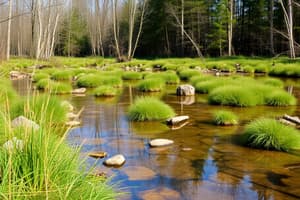Podcast
Questions and Answers
What is Ecology?
What is Ecology?
The study of how living things interact with each other and their environment.
Define Biosphere.
Define Biosphere.
Parts of the earth's air, water, and soil where life is found.
What is an Ecosystem?
What is an Ecosystem?
A community of different species interacting with one another and with their nonliving environment of matter and energy.
What is a Community?
What is a Community?
Define Population in ecological terms.
Define Population in ecological terms.
What is an Organism?
What is an Organism?
What are the three types of symbiotic relationships?
What are the three types of symbiotic relationships?
Define Mutualism.
Define Mutualism.
What is Commensalism?
What is Commensalism?
Define Parasitism.
Define Parasitism.
What is a Niche?
What is a Niche?
Define Resource Partitioning.
Define Resource Partitioning.
Which of the following are terrestrial biomes? (Select all that apply)
Which of the following are terrestrial biomes? (Select all that apply)
What defines a Tropical Rainforest?
What defines a Tropical Rainforest?
Describe Polar Ice as a biome.
Describe Polar Ice as a biome.
What characterizes a Savanna?
What characterizes a Savanna?
Define Desert.
Define Desert.
What defines a Coniferous Forest?
What defines a Coniferous Forest?
What characterizes a Temperate Deciduous Forest?
What characterizes a Temperate Deciduous Forest?
Define Chaparral.
Define Chaparral.
Describe Temperate Grassland.
Describe Temperate Grassland.
What is a Tundra?
What is a Tundra?
Define Canopy in rainforest context.
Define Canopy in rainforest context.
What is Understory in a forest?
What is Understory in a forest?
Define Predator-Prey Relationship.
Define Predator-Prey Relationship.
Flashcards are hidden until you start studying
Study Notes
Ecology and Ecosystems
- Ecology: Study of interactions between living organisms and their environment.
- Biosphere: Regions of air, water, and soil on Earth that support life.
- Ecosystem: Community of interacting species with their physical environment.
- Community: Various populations of species living and interacting in a specific area.
- Population: Group of individuals belonging to the same species in a certain location.
- Organism: An individual living entity.
Symbiotic Relationships
- Three main types of symbiosis:
- Mutualism: Both species benefit from the relationship.
- Commensalism: One organism benefits, the other is unaffected.
- Parasitism: One organism benefits at the expense of the other.
Niche and Resource Use
- Niche: Specific role or function of an organism in its ecosystem, including habitat and behaviors.
- Resource Partitioning: Species reduce competition by dividing available resources.
Terrestrial Biomes
- Tropical Rainforest: High biodiversity; near the equator; dense canopy; hosts diverse flora and fauna.
- Polar Ice: Extremely cold biome with no plant life; home to polar bears and penguins.
- Savanna: Grasslands with scattered trees; warm climate with wet and dry seasons; populated by various large animals.
- Desert: Very dry environment; extreme temperature fluctuations; flora and fauna adapted for minimal water.
- Coniferous Forest: Known as Taiga; characterized by cone-bearing evergreen trees and long, cold winters.
- Temperate Deciduous Forest: Trees shed leaves in autumn; experiences changing seasons; diverse wildlife.
- Chaparral: Dense evergreen shrubs; adapted to survive wildfires; seasonal rainfall patterns.
- Temperate Grassland: Deep, nutrient-rich soil; known as Prairies; supports grazing animals.
- Tundra: Cold, treeless plains with permafrost; short growing season; limited vegetation.
Plant and Animal Adaptations
- Canopy: Dense layer formed by the tops of tall rainforest trees.
- Understory: Shady layer of shorter plants beneath the canopy.
- Predator-Prey Relationship: Dynamic where one organism hunts and consumes another.
Notable Features of Forests
- World's Largest Forests:
- Sahara Desert as the largest non-polar desert.
- The Great Basin Desert as the largest desert in the U.S.
Studying That Suits You
Use AI to generate personalized quizzes and flashcards to suit your learning preferences.




